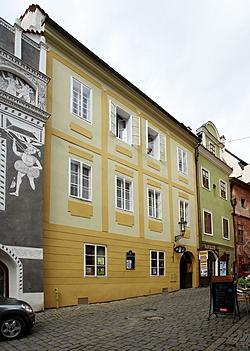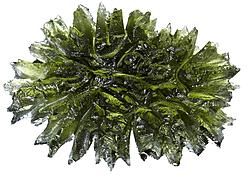New Museum in Český Krumlov Tells the Story of Moldavite
 The only museum in the world that focuses exclusively on Moldavite is currently being established in Český Krumlov. The Civic Association "Museum of Moldavite" will open its museum doors on Thursday June 20th at 9 a.m. at No. 19 Panská Street. The exhibition located on two floors will be interactive, with the aim of attracting not only geological enthusiasts, but regular folk as well. Visitors coming here will find microscopes and other various audiovisual equipment in addition to the collection of these precious stones from the South Bohemian, Moravian and Cheb regions.
The only museum in the world that focuses exclusively on Moldavite is currently being established in Český Krumlov. The Civic Association "Museum of Moldavite" will open its museum doors on Thursday June 20th at 9 a.m. at No. 19 Panská Street. The exhibition located on two floors will be interactive, with the aim of attracting not only geological enthusiasts, but regular folk as well. Visitors coming here will find microscopes and other various audiovisual equipment in addition to the collection of these precious stones from the South Bohemian, Moravian and Cheb regions.
"We would like to show all the qualities for which these stones are considered so beautiful. People will become acquainted with the stones' basic shapes, surface types, and range of colors. The visitors will soon discover that one green can be quite different from another," explains Vit Kršul of the Civic Association, which was founded seven years ago with the aim of establishing this museum. The museum will showcase the most representative samples of Moldavite ever seen in public. The origin of these stones, which are also attributed with healing effects, is mysterious. Visitors will learn the whole story of Moldavite in a wider context: from their dramatic emergence to present laboratory experiments as well as interesting facts concerning meteorites, dangerous asteroids or the extinction of large animals in Earth's history.
The museum also plans to provide accompanying lectures, commented tours, and custom-made programs for those interested in geology and schools. "We want this world‘s extraordinary phenomenon presented in an interesting way and at a high professional level," Kršul added. Stones on display are on loan from private collections and selected to show the variety of inanimate nature, which in this aspect is very generous in the south of Bohemia. "People will discover during the tour why all the stones are interesting and why this typical Czech natural gem is a world rarity," the manager of the museum promises. A ten minute film in Czech, English or German and several other languages (with subtitles) will be shown at the beginning of the tour. The cinema can seat 22 persons. The museum was designed by architect Peter Tošovský, and the sponsor is Povltavská Stavební a.s. of Český Krumlov.
Moldavite are a clear natural glass with a wide range of green to brownish hues and a distinctive surface structure. They were formed by a meteorite impact on Earth some 14.5 million years in what is now Bavaria. The meteorite's tremendous energy fused the sand beneath the point of impact and launched it, under enormous pressure, from 250 to 400 km to the northwest, especially to southern Bohemia. Here the stones can still be found in different layers, tertiary gravel sands in particular. The most well-known sites are located on the western edge of České Budějovice Basin between the towns of Písek and Nové Hrady. "One of the advantages is that Český Krumlov is close to these sites and the other is tourism throughout the year. We would like to keep the museum open throughout the winter," added Kršul.
 The museum is another novelty in this year's exhibition offer of Český Krumlov, in addition to two recently opened expositions - the Land Exhibition in the Regional Museum and the newly renovated Synagogue. The Museum of Moldavite was established under the auspices of the city of Český Krumlov, and its official partner is the Český Krumlov Development Fund. Preparatory work was also supported by the South Bohemian Region. Some Moldavite samples can be viewed in the electronic database of the museum at www.vltaviny.cz.
The museum is another novelty in this year's exhibition offer of Český Krumlov, in addition to two recently opened expositions - the Land Exhibition in the Regional Museum and the newly renovated Synagogue. The Museum of Moldavite was established under the auspices of the city of Český Krumlov, and its official partner is the Český Krumlov Development Fund. Preparatory work was also supported by the South Bohemian Region. Some Moldavite samples can be viewed in the electronic database of the museum at www.vltaviny.cz.
Open: from June 20th 2013, daily from 10 a.m. to 6 p.m., Admission: 99,- CZK

This Museum of Moldavite project is partially financed by the European Union.
Reg. No. CZ.1.14/3.1.00/16.02542